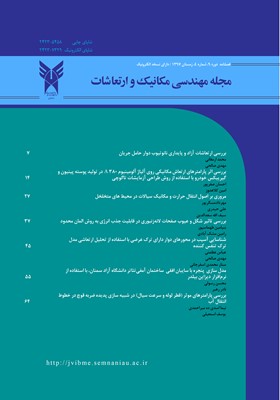طراحی اوّلیّة آب بندهای موتور دوّار پرّه ای بر اساس تحلیل حرارتی
محورهای موضوعی : انتقال ارتعاشاتسیّد مسعود هاشمی 1 , یاسر حسینی 2
1 - هیئت علمی مجتمع مکانیک. دانشگاه مالک اشتر
2 - دانشجو
کلید واژه: انتقال حرارت, تنش حرارتی, توزیع دما, موتور دوّار پرّه ای, اتاق احتراق,
چکیده مقاله :
تاکنون تحقیقات گسترده ای در راستای بهبود کیفیّت و کاهش وزن پیشرانة پرنده های هوایی انجامشده که منجر به ابداع فن آوری های نو و ساخت موتورهای جدیدی شده است. در تمامی این تحقیقات،بررسی توزیع دما و انتقال حرارت در بدنة موتور احتراقی به منظور بررسی مشخصات و عملکرد موتورحائز اهمیّت و ضروری تلقی می شود. یکی از طرح های نوآورانه، طراحی موتور دوّار پرّه ای است که ازآن به عنوان انقلابی در صنعت موتور یاد می شود. در این مقاله به طراحی اولیة آب بندهای این موتور براساس تحلیل حرارتی پرداخته می شود. نحوة افزایش دمای هوا در اتاق احتراق بررسی و توزیع دما با دوروش تخمین مهندسی و تحلیل عددی محاسبه شده است. در تخمین مهندسی از روابط پایة انتقالحرارت جابه جایی، تشعشعی، رسانش و معادلة توازن انرژی استفاده و معادلات بقای انرژی نیز ارضا وفرآیند احتراق به صورت چرخة دیزل مدل شده است. احتراق به صورت چشمة حرارتی لحاظ شده وضرایب انتقال حرارت در قالب کد رایانه ای محاسبه شده است. نتایج تحلیل عددی این مسئله با نتایجبرنامه تخمینی مقایسه و صحه گذاری شده و پوشش و جنس مناسب برای قطعات تشکیل دهندة اتاقاحتراق و نیز جنس و محلّ مناسب آب بندها با توجّه به توزیع دما انتخاب شده است.
Extensive research has been done to improve the quality and reduce the propulsion weight of aircraft, which has led to the invention of new technologies and the construction of new engines. In all these studies, the study of temperature distribution and heat transfer in the body of the combustion engine in order to evaluate the characteristics and performance of the engine is considered important and necessary. One of the most innovative designs is the vane rotary motor design, which is considered to be a revolution in the motor industry. In this article, initial design of the seals of this engine is discussed based on thermal analysis. The method of increasing the air temperature in the combustion chamber has been investigated and the temperature distribution has been calculated by two methods of engineering estimation and numerical analysis. In engineering estimation, the basic relations of heat transfer, radiative, conduction, and energy balance equation are used, and the energy survival equations are satisfied, and the combustion process is modeled as a diesel cycle. Combustion is considered as a heat source and heat transfer coefficients are calculated in the form of computer code. The results of numerical analysis of this issue are compared and validated with the results of the estimation program and the appropriate cover and material for the components of the combustion chamber as well as the appropriate material and location of the seals are selected according to the temperature distribution
_||_


